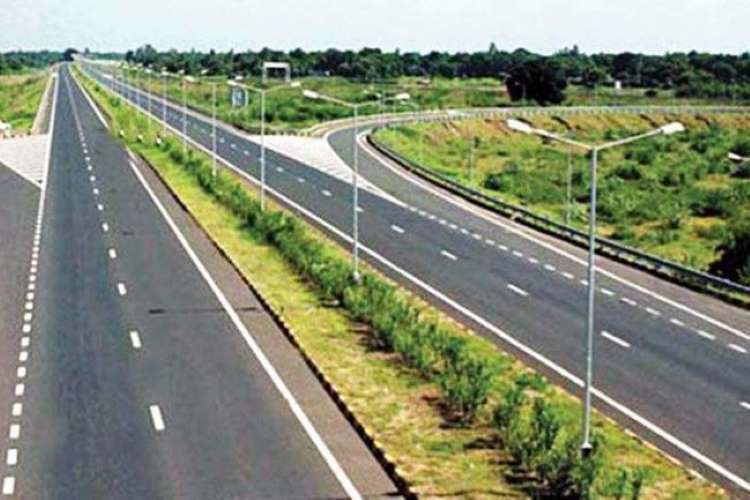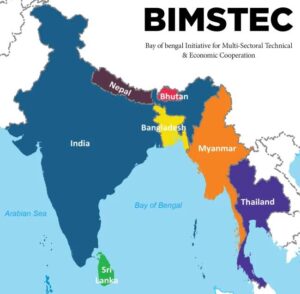
The Bay of Bengal Initiative for Multisectoral Technical and Economic Cooperation is a regional multilateral organisation comprising seven member countries: Bangladesh, Bhutan, India, Nepal, Sri Lanka, Myanmar, and Thailand. Together, these nations account for an estimated 1.7 billion people and a GDP of $5.2 trillion, representing 5% of the global GDP. Established through the 1997 Bangkok Declaration, BIMSTEC initially included Bangladesh, India, Sri Lanka, and Thailand for economic cooperation. Myanmar joined later that year, and Nepal and Bhutan became members in 2004, creating the current full-fledged organisation.

BIMSTEC was formed with the objective of creating an enabling environment for rapid economic development in the region by fostering a spirit of equality and partnership. It seeks to promote collaboration and mutual assistance in areas of common interest to member countries, supporting each other in fields like education, science, and technology. The organisation’s basic principles — sovereign equality, territorial integrity, non-interference in internal affairs, peaceful coexistence, and mutual benefit—supplement bilateral, regional, and multilateral cooperation among member countries.
READ I R&D spending, innovation key to Atmanirbhar Bharat
Need for a stronger BIMSTEC
Key areas of cooperation within BIMSTEC are distributed among member countries: Bangladesh focuses on trade, investment, and development; Bhutan on environment and climate change; India on security, counter-terrorism, transnational crimes, disaster management, and energy; Myanmar on agriculture, food security, fisheries, and livestock; Nepal on people-to-people contact, culture, tourism, think tanks, and media; Sri Lanka on science, technology, innovation, health, and human resource development; and Thailand on connectivity. BIMSTEC is expected to provide India with direct connectivity to Southeast Asia via the Northeast region and Myanmar. This connectivity is crucial for India’s Look East and Act East policies which look to strengthen economic and strategic ties with Southeast Asia.
India should prioritise strengthening BIMSTEC for several reasons. Geopolitically, BIMSTEC’s strategic location connects South and Southeast Asia, bridging the Bay of Bengal and the Himalayas. Strengthening BIMSTEC enhances India’s influence in these regions and counters China’s growing presence through its Belt and Road Initiative.
BIMSTEC members: Key economic indicators

BIMSTEC can also act as a platform for India to engage in collaborative projects that benefit the entire region. For instance, joint initiatives in disaster management can significantly improve resilience against natural calamities, which are common in this part of the world. By pooling resources and expertise, BIMSTEC countries can develop more effective strategies to mitigate the impacts of disasters, thereby enhancing regional stability and safety. Such cooperation can also extend to areas like public health, where collaborative efforts in research and development can lead to better healthcare outcomes for all member countries.
Economically, enhanced connectivity with Southeast Asia is expected to accelerate economic development in India’s Northeastern region by linking it to the Bay of Bengal region via Bangladesh and Myanmar. This linkage has long been a strategic goal for India, promising economic integration and growth. Furthermore, BIMSTEC promotes regional cooperation in key sectors such as security, connectivity, trade, agriculture, environment, science, technology, and people-to-people contact. Strengthening BIMSTEC can lead to more effective collaboration in these areas, fostering regional stability and mutual growth.
The potential for cultural exchange and tourism between BIMSTEC countries also presents a unique opportunity for strengthening regional ties. Promoting tourism within the region can not only boost economic growth but also foster a deeper understanding and appreciation of the diverse cultures and traditions that exist within BIMSTEC. This cultural exchange can lay the groundwork for stronger, more harmonious relations between member states, contributing to the overall goal of regional unity and cooperation.
READ I Car exports dream stalled: Can the industry shift gears by 2030?
Challenges and opportunities
While BIMSTEC holds significant potential, it faces several challenges. Intra-regional trade and investment within BIMSTEC have been below expectations, primarily due to poor connectivity and an infrastructure investment gap estimated at around $120 billion annually. Despite improvements in physical connectivity, digital and people-to-people connectivity remain major challenges. Additionally, the lack of development finance is a major handicap for BIMSTEC. Experts suggest addressing this by engaging multilateral institutions like the Asian Development Bank and friendly countries, including the USA and Japan.
BIMSTEC can also collaborate with private financial institutions and cross-border entities to mobilise resources. Moreover, regional disputes, such as the growing discord between Bangladesh and Myanmar over the Rohingya refugee crisis, pose significant challenges. Addressing such disputes requires diplomatic efforts and a commitment to regional cooperation. Competing influences, particularly China’s massive infrastructure projects in South and Southeast Asia under its Belt and Road Initiative, also present strategic challenges. India must counter this by leveraging BIMSTEC to enhance its own regional influence.
India’s strategic role
India should develop a comprehensive strategy to leverage its soft power in South, East, and Southeast Asia through BIMSTEC. This involves promoting trade and investment, facilitating trade, reducing barriers, and encouraging economic integration among BIMSTEC members.
India should also focus on leveraging its technological advancements to benefit BIMSTEC. By sharing its expertise in digital technology and innovation, India can help bridge the digital divide within the region. Initiatives such as providing technical training, setting up innovation hubs, and promoting digital literacy can empower member countries to better integrate into the global digital economy. This, in turn, can lead to more robust economic growth and development across the region. Exploring possibilities for an effective Free Trade Agreement could boost trade and investment in the region. Enhancing connectivity is also crucial. Improving physical, digital, and people-to-people connectivity requires investments in infrastructure.
Bhutan and Nepal possess significant hydropower potential that exceeds their domestic requirements, offering ample opportunities to meet India’s rising energy needs. Collaborating on renewable energy projects can strengthen regional ties and promote sustainable development.
Addressing the infrastructure investment gap is also critical. India, in collaboration with other BIMSTEC members, should actively seek funding from international financial institutions and private sector investors. By developing comprehensive infrastructure projects, such as roads, railways, and ports, the region can significantly improve its connectivity and logistical capabilities. This improved infrastructure will not only facilitate trade and investment but also enhance the overall economic integration of the BIMSTEC region.
Additionally, India should strengthen cooperation in security, counter-terrorism, and disaster management, as these areas are vital for regional stability and mutual trust. BIMSTEC represents a strategic opportunity for India to strengthen its regional footprint and promote economic growth and stability. By addressing the challenges and leveraging the opportunities, India can play a pivotal role in transforming BIMSTEC into a robust platform for regional cooperation. This not only serves India’s national interests but also contributes to the prosperity and stability of the broader region. Strengthening BIMSTEC is not just an option for India; it is a strategic imperative.
(The author is an economist based in Kochi. He was the head of the Department of Economics, Central University of Kerala, Kasaragod.)
Ravindran AM
Ravindran AM is an economist based in Kochi. He was the head of Department of Economics at the Central University of Kerala. He has also served as Associate Professor, Directorate of Higher Education, Puducherry.

